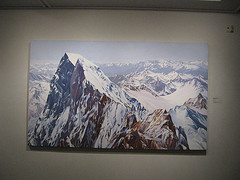
Diane Burko’s Grandes Jorasses at Marguerite, 1976, acrylic on canvas
I’ve never visited the Michener Museum in Doylestown–it’s so far and uncontemporary. But a visit to artists Diane Burko and Richard Ryan in their place north of Bucks County last weekend was a good opportunity to visit the nearby museum and see the Burko exhibit, Flow.
I saw work–mountains–that I haven’t seen for years. And I saw some of Burko’s recent photographs, as well as relatively recent paintings on subjects like the Wissahickon and Icelandic thermal pools.
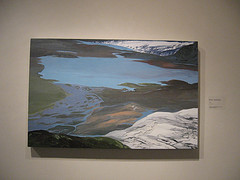
Glacier, Jokulsklaron, 2005, oil on canvas, the tilt of the piece undermined alas by my camera’s tilt
The gallery introduction, by curator Amy Schlegel, mentioned the important place of liquid flow and its relationship to stablility and instability in Burko’s work. I found myself marveling at how Burko’s Alps from 1978 looked like they were flowing. I was especially interested in the pieces that seemed to be taken from a tilted position, suggesting the slippery slope on which we all stand.
I suppose my interest in the off-balance may be a reflection of my realization that I must be crooked myself, because all of my photos are atilt, try though I might to stand straight and hold the camera level.
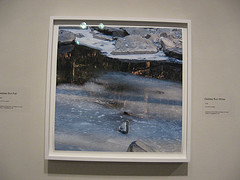
Geddes Run Winter, Iris print on paper, 2006; sorry about all the reflections
I especially enjoyed the theme as carried out in the photographs, which to my mind’s eye overtly tip their emotional substance in a way the cooler paintings decline. The focused details, the play of light and dark, and the passion for land and water come through, along with Burko’s life-long exploration of the power of nature–its tranquility, its transcendance, and its threat.
The decisions on what’s within the picture frame and what isn’t feels to me like a struggle to dominate the indomitable, and reminds me a bit of Ed Ruscha, who tries to dominate nature with an application of words.
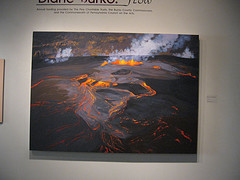
Halema’uma’u Crater #3, 2000, oil on canvas; the arched horizon suggests this volcanic turbulence is what the earth is
This is a time when we on earth are questioning our relationship to the planet’s survival, and suddenly Burko’s themes take on an urgency as she’s incorporated into eco shows. But Burko is more of a landscape painter in the romantic tradition, a transcendental painter, rather than a eco painter. But the cool edge-decisions undercut the wide-eyed admiration of what’s out there, and place the work in a more recent time of somewhat diminished optimism and a sense of worry. It’s an outlook that parallels that of arctic explorers and extreme mountain climbers, with its mix of admiration for nature’s grandeur and the desire to prove oneself.
This exhibit also showed at Tufts University earlier this year.
When I was first arrived at the Michener, the first piece I saw was an Isaac Witkin. He and I had had a long talk just a year ago–on my last visit to Burko and Ryan’s country place- and he seemed a bit disspirited, unhappy with how his work looked on Locks Gallery’s roof garden and just bummed out about everything. Since then, he passed away, and I couldn’t help but think of our talk and his spiritual exhaustion when I saw his piece at the Michener.
In that frame of mind, the 9/11 watercolors on view by Todd Stone seemed a trifle cheerful, given their subject matter. The work was made in 2002. The subject matter, still so fresh to us, made me pay attention. The fallen trade towers, Collapse, shows two billowing towers of ashy clouds; the piece brings to mind the controversy now all over the internet about doctored photographs of plumes of smoke in Lebanon.
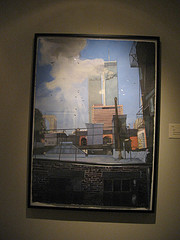
8:01 by Todd Stone, watercolor
The painting 8:01 shows the horizontal gash from the plane and its wings clearly defined in the first tower in the cool morning light. The detail in the narrative here is powerful, the high-tech verticality of the towers so shockingly vulnerable and pregnant with the future we already know. There’s irony in the contrasting strength in the misshapen, low tech rooftops of the foreground, which become metaphors for people affected by events beyond our control. These were powerful choices. But most of the pictures are far too pretty, with clouds of debris merging with clouds in the sky, all horror lost to a beauty that seems at odds. Ultimately, my sapometer exploded when I looked at the last painting in the series–birds in a blue, cloudy sky. It was just another birds in the sky painting.
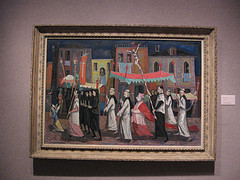
Procession, 1952, by Louis Boza, which blends a Medieval saints procession with a modern angularity, sadness with humor, and an outsidery flatness with painterly know-how
Since I had never been at the Michener, I wandered a little but missed the Nakashima Reading Room. But I liked some Edward Hicks and a piece called Procession by Louis Boza with a horizontal array of figures–festive and funereal all at once–and a horizontal array of windows looking down. For more images of what I saw, visit my Flickr set.
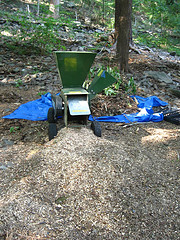
The chipper and chips in Richard Ryan and Diane Burko’s fabulous garden, which proceeds like a series of rooms
I also took a bunch of photos of the garden at Diane and Richard’s house. It made me think of my dear friend and neighbor Mac Fisher, who in his last years poured all his love of beauty and nature into his little backyard, even though he could barely lift a shovel. The Burko-Ryan garden is a grand passion. Oh sure, it’s not as big as Winterthur, let’s say. Rather, it’s a personal garden, its scale and ideas ambitious for people without full-time gardeners. I say it’s art. Here’s this year’s Flicker set of the garden.








